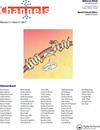β-Raf activation of the myocardial Na+/H+ exchanger
IF 3.2
3区 生物学
Q2 BIOCHEMISTRY & MOLECULAR BIOLOGY
引用次数: 1
Abstract
The NaC/HC exchanger isoform 1 (NHE1) is a ubiquitous plasma membrane protein that regulates intracellular pH in isolated cardiomyocytes and in other mammalian cells. The N-terminal domain of approximately 500 amino acids is responsible for removal of one intracellular proton in exchange for one extracellular sodium. The intracellular C-terminal of 315 amino acids regulates the membrane domain and is post translationally modified by protein kinase mediated phosphorylation (Fig. 1). NHE1 is intimately involved in heart disease. It contributes to ischemia reperfusion mediated injury. During ischemia, acid load increases and the resultant increase in NHE1 activity contributes to increased intracellular sodium. This elevated sodium leads to reversal of activity of the NaC/Ca2C exchanger and results in an increase in intracellular calcium, triggering deleterious pathways that lead to cell damage and death. Elevated NHE1 activity also contributes to cardiac hypertrophy and its inhibition can prevent cardiac hypertrophy. NHE1 is regulated by protein kinase mediated phosphorylation through the mitogen-activated protein kinase (MAPK) signaling pathway. This pathway of Ras-Raf-MEK-ERK/MAPK (Fig. 1) is conserved and controls a variety of cellular processes including proliferation and metabolism in different cell types. Raf, has three isoforms A-Raf, b¡Raf and Raf-1. The Ser/Thr kinase b-Raf, has mutations in very high frequency in melanomas and in lower frequencies in other types of cancer. The V600E mutation is the most prominent and found in most patients with a b-Raf mutation. The NHE1 protein shares some of the physiological roles of b-Raf being involved in cellular proliferation and promoting tumourigenesis. This led us to examine the potential role of b-Raf in regulation of NHE1 and intracellular pH in malignant melanoma cells with the b-Raf mutation. We demonstrated that melanoma cells with the b-RafV600E mutation had elevated resting intracellular pH that was dependent on NHE1. Also, inhibition or knock down of b-Raf decreased NHE1 activity. This report confirmed that b-Raf is capable of regulation of NHE1 in malignant melanoma cells, but how does this occur and is it common in other cell types? In that study we also demonstrated that b-Raf binds to the cytosolic regulatory domain. b-Raf immunoprecipitated with NHE1 in both HeLa and HEK (human embryonic kidney) cells. Another observation was that in a screen for protein kinases from the heart that bind to the NHE1 tail, the strongest signal observed was an interaction between the NHE1-C terminus and b-Raf. This suggested to us that there may be a regulatory role for b-Raf in the myocardium. It is notable that b-Raf has also been implicated in cardiac hypertrophy in addition to NHE1. It thus occurred to us that there may be a link between b-Raf and NHE1 that is responsible. Our follow up work therefore examined whether b-Raf can regulate NHE1 in myocardial cells. In isolated cardiomyocytes, inhibition or knockdown of b-Raf reduced NHE1 activity, confirming that b-Raf plays a significant role in modulation NHE1 in the myocardium. Cell extracts from isolated cardiomyocytes contained b-Raf that bound to NHE1 andβ-Raf激活心肌Na+/H+交换器
NaC/HC交换物异构体1 (NHE1)是一种普遍存在的质膜蛋白,在分离的心肌细胞和其他哺乳动物细胞中调节细胞内pH。大约500个氨基酸的n端结构域负责去除一个细胞内质子以换取一个细胞外钠。315个氨基酸的胞内c端调控膜结构域,并通过蛋白激酶介导的磷酸化进行翻译后修饰(图1)。NHE1与心脏病密切相关。它有助于缺血再灌注介导的损伤。在缺血期间,酸负荷增加,NHE1活性随之增加,导致细胞内钠增加。这种升高的钠导致NaC/Ca2C交换器活性的逆转,并导致细胞内钙的增加,引发导致细胞损伤和死亡的有害途径。NHE1活性升高也有助于心肌肥厚,抑制其可预防心肌肥厚。NHE1通过丝裂原活化蛋白激酶(MAPK)信号通路受蛋白激酶介导的磷酸化调控。Ras-Raf-MEK-ERK/MAPK的这条通路(图1)是保守的,在不同的细胞类型中控制着多种细胞过程,包括增殖和代谢。Raf,有三个同工异构体A-Raf, b′Raf和Raf-1。丝氨酸/苏氨酸激酶b-Raf,在黑色素瘤中频率很高在其他类型的癌症中频率较低。V600E突变是最突出的,在大多数b-Raf突变患者中发现。NHE1蛋白分享了b-Raf参与细胞增殖和促进肿瘤发生的一些生理作用。这使我们研究了b-Raf在具有b-Raf突变的恶性黑色素瘤细胞中调控NHE1和细胞内pH的潜在作用。我们证明了具有b-RafV600E突变的黑色素瘤细胞具有依赖于NHE1的静息细胞内pH值升高。此外,抑制或敲低b-Raf可降低NHE1活性。该报告证实b-Raf能够调节恶性黑色素瘤细胞中的NHE1,但这是如何发生的,在其他细胞类型中是否常见?在该研究中,我们还证明了b-Raf与细胞质调节结构域结合。b-Raf与NHE1在HeLa和HEK(人胚胎肾)细胞中均有免疫沉淀。另一个观察结果是,在筛选与NHE1尾部结合的心脏蛋白激酶时,观察到的最强信号是NHE1- c末端和b-Raf之间的相互作用。这提示我们b-Raf可能在心肌中具有调节作用。值得注意的是,除了NHE1外,b-Raf也与心脏肥厚有关。因此,我们想到b-Raf和NHE1之间可能存在联系。因此,我们的后续工作研究了b-Raf是否可以调节心肌细胞中的NHE1。在分离的心肌细胞中,抑制或敲低b-Raf可降低NHE1活性,证实b-Raf在心肌中调节NHE1中起重要作用。分离心肌细胞的细胞提取物中含有b-Raf,它与NHE1和NHE1结合
本文章由计算机程序翻译,如有差异,请以英文原文为准。
求助全文
约1分钟内获得全文
求助全文
来源期刊

Channels
生物-生化与分子生物学
CiteScore
5.90
自引率
0.00%
发文量
21
审稿时长
6-12 weeks
期刊介绍:
Channels is an open access journal for all aspects of ion channel research. The journal publishes high quality papers that shed new light on ion channel and ion transporter/exchanger function, structure, biophysics, pharmacology, and regulation in health and disease.
Channels welcomes interdisciplinary approaches that address ion channel physiology in areas such as neuroscience, cardiovascular sciences, cancer research, endocrinology, and gastroenterology. Our aim is to foster communication among the ion channel and transporter communities and facilitate the advancement of the field.
 求助内容:
求助内容: 应助结果提醒方式:
应助结果提醒方式:


